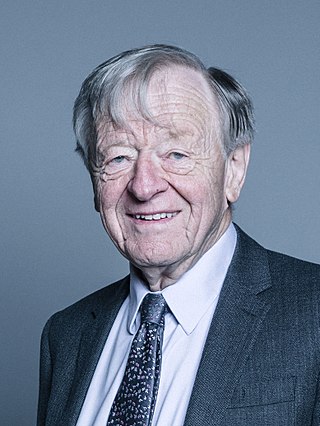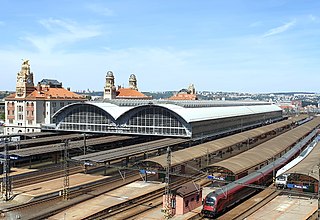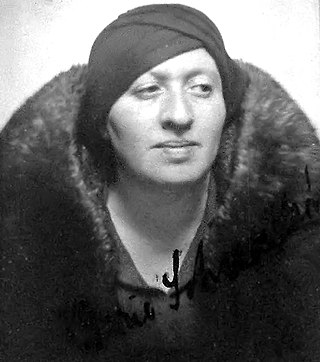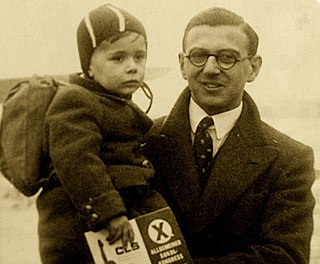
The Kindertransport was an organised rescue effort of children from Nazi-controlled territory that took place in 1938–1939 during the nine months prior to the outbreak of the Second World War. The United Kingdom took in nearly 10,000 children, most of them Jewish, from Germany, Austria, Czechoslovakia, Poland, and the Free City of Danzig. The children were placed in British foster homes, hostels, schools, and farms. Often they were the only members of their families who survived the Holocaust that was to come. The programme was supported, publicised, and encouraged by the British government, which waived the visa immigration requirements that were not within the ability of the British Jewish community to fulfil. The British government placed no numerical limit on the programme; it was the start of the Second World War that brought it to an end, by which time about 10,000 kindertransport children had been brought to the country.

Alfred Dubs, Baron Dubs is a British Labour politician and former Member of Parliament.

Maidenhead railway station serves the market town of Maidenhead, Berkshire, England. It is 24 miles 19 chains (39.0 km) down the line from London Paddington and is situated between Taplow to the east and Twyford to the west.

Sir Nicholas George Winton was a British stockbroker and humanitarian who helped to rescue Jewish children who were at risk of being murdered by Nazi Germany during the Holocaust. Born to German-Jewish parents who had immigrated to Britain at the beginning of the 20th century, Winton assisted in the rescue of 669 children, most of them Jewish, from Czechoslovakia on the eve of World War II. On a brief visit to Czechoslovakia, he helped compile a list of children needing rescue and, returning to Britain, he worked to fulfill the legal requirements of bringing the children to Britain and finding homes and sponsors for them. This operation was later known as the Czech Kindertransport.
Josef Schlesinger, was a Canadian foreign correspondent, television journalist, and author.

Harwich International railway station is a railway station on the Mayflower Line, a branch of the Great Eastern Main Line, the station serves Harwich International Port in Essex, England. It is 68 miles 72 chains (110.88 km) from London Liverpool Street, between Wrabness to the west and Dovercourt to the east. Its three-letter station code, HPQ, derives from its original name, Harwich Parkeston Quay.

Praha hlavní nádraží is the largest railway station in Prague, Czech Republic.
Heini Halberstam was a Czech-born British mathematician, working in the field of analytic number theory. He is remembered in part for the Elliott–Halberstam conjecture from 1968.

The Fifteen Guinea Special was the last main-line passenger train to be hauled by steam locomotive power on British Rail on 11 August 1968 before the introduction of a steam ban that started the following day, the extra day added to allow for the movement of locomotive BR Standard Class 7 70013 Oliver Cromwell to Bressingham Steam Museum. It was a special rail tour excursion train organised for the occasion from Liverpool Lime Street via Manchester Victoria to Carlisle and back, and was pulled in turn by four steam locomotives during the four legs of the journey. The last scheduled standard gauge steam-hauled passenger services had run on 3 August 1968 from Preston. Steam continued to be used on the narrow gauge Vale of Rheidol Railway under British Rail, which was subsequently privatised in 1989.

The Hook Continental was a passenger train running between London's Liverpool Street Station and Harwich Parkeston Quay where it connected with the night ferry sailing to the Hook of Holland in the Netherlands. It was introduced as a named express by the London and North Eastern Railway (LNER) in 1927, and was part of the marketing strategy pushing the concept of almost seamless travel from London overnight to numerous European destinations utilising the company's own ships and the rail connections from the Hook of Holland.
All My Loved Ones is a 1999 Czech-language film directed by Matej Mináč. It was an international co-production between Poland, the Czech Republic and Slovakia. It was Slovakia's official Best Foreign Language Film submission at the 72nd Academy Awards, but did not manage to receive a nomination.

The Balkan Express was an international overnight passenger train that ran between Istanbul, Turkey and Belgrade, Serbia, via Sofia, Bulgaria. The train began operations in 1991 from Istanbul to Budapest, Hungary, but was cut back to Belgrade after 2000. Service was discontinued in March 2013, when Sirkeci station closed for the construction of the Marmaray commuter rail network. In 2017, the Istanbul-Sofia Express was inaugurated as a successor to the Balkan Express, although the route was shortened to Sofia.
The Power of Good: Nicholas Winton is a 2002 documentary about Nicholas Winton, the man who organized the Kindertransport rescue mission of 669 children from German-occupied Czechoslovakia on the eve of the Second World War. Director Matej Mináč was inspired by meeting Winton while developing the film treatment for All My Loved Ones.

Trevor Chadwick was a British humanitarian who was involved in the Kindertransport to rescue Jews and other refugee children in Czechoslovakia in 1938–1939 before World War II. After the Munich Agreement Nazi Germany annexed Sudetenland from Czechoslovakia in 1938 and occupied the whole Czech part of Czechoslovakia in 1939. The children were mostly resettled with families in the United Kingdom.

Doreen Agnes Rosemary Julia Warriner was an English development economist and humanitarian. In October 1938, she journeyed to Czechoslovakia to assist anti-Nazi refugees fleeing the Sudetenland, recently occupied by Germany. She became the head of the British Committee for Refugees from Czechoslovakia in Prague which helped 15,000 German, Czech, and Jewish refugees escape Czechoslovakia while the country was being occupied and annexed by Nazi Germany in 1938 and 1939. Told that she would be arrested by the Germans Warriner departed Czechoslovakia on 23 April 1939. She was awarded an OBE in 1941. After the War, she was an academic at the School of Slavonic and East European Studies.

Kolín railway station is a railway station in the city of Kolín on the Elbe river in Central Bohemian Region, Czech Republic.

Marie Schmolka was a Czechoslovak Jewish activist and social worker who helped political refugees and Jewish adults and children escape the Protectorate of Bohemia and Moravia in the lead-up to World War II. She was a member of WIZO and WILPF. She had previously helped refugees from Germany who fled to Czechoslovakia after the Nazi rise to power. Schmolka headed the newly founded Czechoslovak Refugee Committee, and also chaired local HICEM. In July 1938, she represented Czechoslovakia at the Évian conference.
Vera Gissing was a Czech-British writer, translator, and one of "Winton's children", the children saved by the actions of Nicholas Winton. Her sister, who accompanied her on the kindertransport, was the diarist and nurse Eva Hayman.

One Life is a 2023 biographical drama film directed by James Hawes. Based on the true story of British humanitarian Nicholas Winton, the film alternates between following Anthony Hopkins as a 79-year old Winton reminiscing on his past, and Johnny Flynn as a 29-year old Winton attempting to help groups of Jewish children in German-occupied Czechoslovakia to hide and flee in 1938–39, just before the beginning of World War II. Helena Bonham Carter, Lena Olin, Romola Garai, Alex Sharp and Jonathan Pryce co-star in supporting roles.

The Hansi Neumann flight was the first flight to evacuate refugee children from Prague, Czechoslovakia, to Croydon, England, in January 1939, in the lead up to the Second World War. Part of the Czech kindertransport, it was completed in a Dutch Douglas aircraft of KLM, and organised by the Barbican Mission to Jewish People and the British Committee for Refugees from Czechoslovakia (BCRC). Around 18 Jewish children were on the flight.























